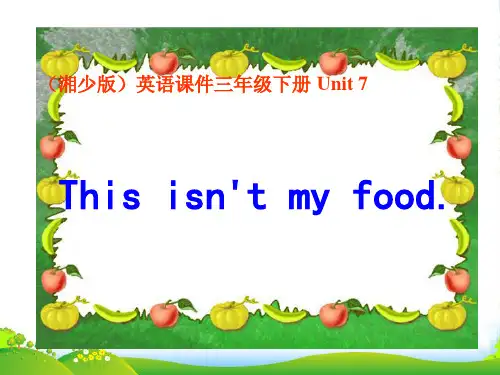湘教版英语三年级下册单元知识汇总梳理-Unit 7
- 格式:doc
- 大小:13.00 KB
- 文档页数:1

目录Unit 1 How are you ? (2)一、单词: (2)二、句型: (2)Unit 2 Are you Lingling? (3)一、单词: (3)二、句型: (3)Unit 3 What color is this balloon? (4)一、单词: (4)二、句型: (4)一、单词: (5)二、句型: (5)Unit 5 What’s the time ? (6)一、单词: (6)二、句型: (6)Unit 6 How many pens are there? (7)一、单词: (7)二、句型: (7)Unit 7 Is this an orange? (8)一、单词: (8)二、句型: (8)Unit 8 I like a sunny day (9)一、单词: (9)二、句型: (9)Unit 9 What’s the weather like? (10)一、单词: (10)二、句型: (10)Unit 10 Is he a farmer? (11)一、单词: (11)二、句型: (11)Unit 11 What’s he? (12)一、单词: (12)二、句型: (12)Unit 12 I go to school by bus (13)一、单词: (13)二、句型: (13)Unit 1 How are you ?一、单词:how 怎样 well 好 glad 高兴的 see 看见again 再次 fine 好的 too 也 now 现在evening 晚上 night 晚上 begin 开始二、句型:1.Good morning, Peter. 早上好,彼得。
2.I’m glad to see you again. 很高兴再次看到你。
3.How are you? 你好吗?4.I’m fine.And you? 我很好。
你呢?5.I’m fine, too. 我也很好。
Unit 2 Are you Lingling?一、单词:boy 男孩 girl 女孩 baby 婴儿 man 男人 woman 女人二、句型:1.Here you are.给你。
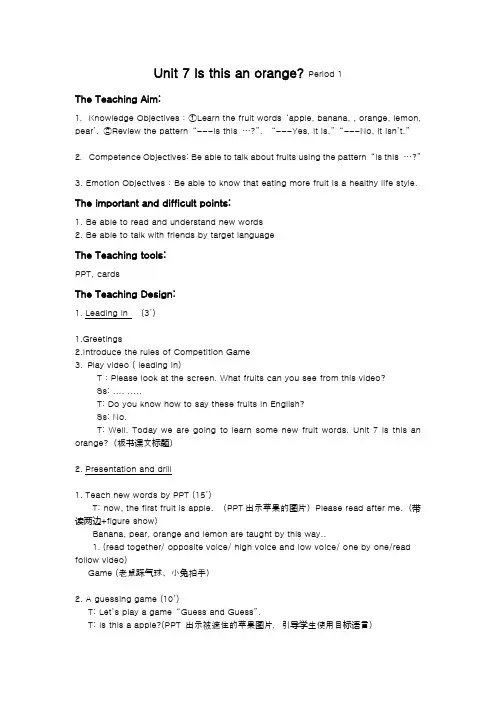
Unit 7 Is this an orange?Period 1The Teaching Aim:1.Knowledge Objectives:①Learn the fruit words ‘apple, banana, , orange, lemon, pear’. ②Review the pattern “---Is this …?”. “---Yes, it is.”“---No, it isn’t.”2.Competence Objectives: Be able to talk about fruits using the pattern “Is this …?”3. Emotion Objectives:Be able to know that eating more fruit is a healthy life style. The important and difficult points:1. Be able to read and understand new words2. Be able to talk with friends by target languageThe Teaching tools:PPT, cardsThe Teaching Design:1.Leading in (3’)1.Greetings2.Introduce the rules of Competition Game3. Play video ( leading in)T:Please look at the screen. What fruits can you see from this video?Ss: .... .....T: Do you know how to say these fruits in English?Ss: No.T: Well. Today we are going to learn some new fruit words. Unit 7 Is this an orange?(板书课文标题)2.Presentation and drill1.Teach new words by PPT (15’)T: now, the first fruit is apple. (PPT出示苹果的图片)Please read after me.(带读两边+figure show)Banana, pear, orange and lemon are taught by this way..1.(read together/ opposite voice/ high voice and low voice/ one by one/read follow video)Game (老鼠踩气球、小兔拍手)2. A guessing game (10’)T: Let’s play a game “Guess and Guess”.T: Is this a apple?(PPT 出示被遮住的苹果图片,引导学生使用目标语言)S: Yes.T:Is this a pear? ( show banana)S: No.... ....(板书)(强调Yes后面要接上it is, No后面要接上it isn’t.注意isn’t的发音)let one S ask, another answer. 再次操练句型(depends on time)3.Summary1.Keep an apple a day keeps doctor away2.The consequence of competition3.Words and sentences5.Homework1. Copy new words 5 times2. Preview Part A6.Blackboard DesignUnit 7 Is this an orange?Is this a/ an applebanana ? Yes, it is.pear No, it isn’t.orangelemon。
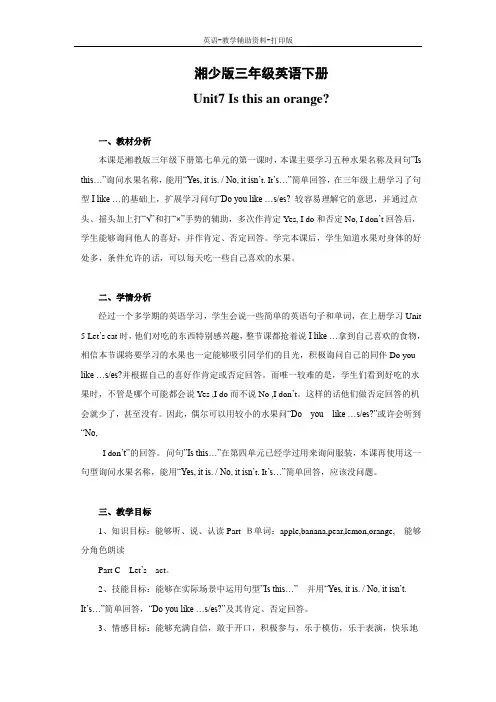
湘少版三年级英语下册Unit7 Is this an orange?一、教材分析本课是湘教版三年级下册第七单元的第一课时,本课主要学习五种水果名称及问句”Is this…”询问水果名称,能用“Yes, it is. / No, it isn’t. It’s…”简单回答,在三年级上册学习了句型I like …的基础上,扩展学习问句“Do you like …s/es? 较容易理解它的意思,并通过点头、摇头加上打“√”和打“×”手势的辅助,多次作肯定Yes, I do和否定No, I don’t回答后,学生能够询问他人的喜好,并作肯定、否定回答。
学完本课后,学生知道水果对身体的好处多,条件允许的话,可以每天吃一些自己喜欢的水果。
二、学情分析经过一个多学期的英语学习,学生会说一些简单的英语句子和单词,在上册学习Unit 5 Let’s eat时,他们对吃的东西特别感兴趣,整节课都抢着说I like …拿到自己喜欢的食物,相信本节课将要学习的水果也一定能够吸引同学们的目光,积极询问自己的同伴Do you like …s/es?并根据自己的喜好作肯定或否定回答。
而唯一较难的是,学生们看到好吃的水果时,不管是哪个可能都会说Yes ,I do而不说No ,I don’t。
这样的话他们做否定回答的机会就少了,甚至没有。
因此,偶尔可以用较小的水果问“Do you like …s/es?”或许会听到“No,I don’t”的回答。
问句”Is this…”在第四单元已经学过用来询问服装,本课再使用这一句型询问水果名称,能用“Yes, it is. / No, it isn’t. It’s…”简单回答,应该没问题。
三、教学目标1、知识目标:能够听、说、认读Part B单词:apple,banana,pear,lemon,orange, 能够分角色朗读Part C Let’s act。
2、技能目标:能够在实际场景中运用句型”Is this…” 并用“Yes, it is. / No, it isn’t. It’s…”简单回答,“Do you like …s/es?”及其肯定、否定回答。
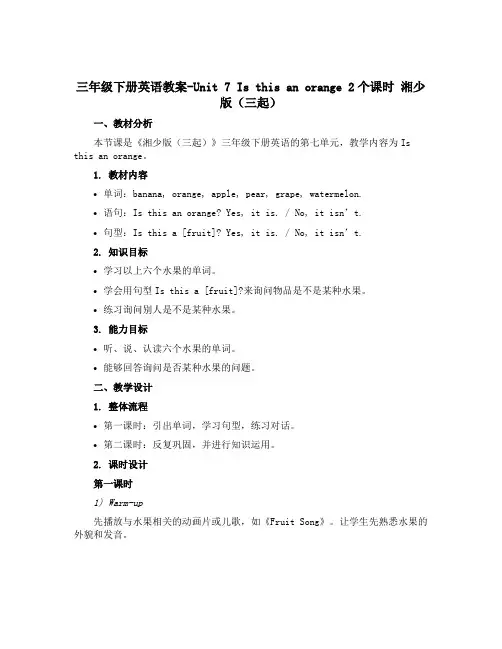
三年级下册英语教案-Unit 7 Is this an orange 2个课时湘少版(三起)一、教材分析本节课是《湘少版(三起)》三年级下册英语的第七单元,教学内容为Is this an orange。
1. 教材内容•单词:banana, orange, apple, pear, grape, watermelon.•语句:Is this an orange? Yes, it is. / No, it isn’t.•句型:Is this a [fruit]? Yes, it is. / No, it isn’t.2. 知识目标•学习以上六个水果的单词。
•学会用句型Is this a [fruit]?来询问物品是不是某种水果。
•练习询问别人是不是某种水果。
3. 能力目标•听、说、认读六个水果的单词。
•能够回答询问是否某种水果的问题。
二、教学设计1. 整体流程•第一课时:引出单词,学习句型,练习对话。
•第二课时:反复巩固,并进行知识运用。
2. 课时设计第一课时1) Warm-up先播放与水果相关的动画片或儿歌,如《Fruit Song》。
让学生先熟悉水果的外貌和发音。
2) Presentation•出示单词banana, orange, apple, pear, grape, watermelon,让学生边看边读。
•老师用不同的水果向学生提问,学生看图答出水果的单词。
•用句型Is this a [fruit]?的形式引出句子。
•利用幻灯片或图片,在黑板或PPT上让学生看到不同的水果,用句型Isthis a [fruit]?让学生回答。
3) Practice•学生和老师进行以下对话:–T: Is this an apple?–S1: Yes, it is.–T: Is this a watermelon?–S2: No, it isn’t.•学生带着自己的图片卡片与同桌进行对话。
卡片上是一种随机的水果,同桌要用句型Is this a [fruit]?的形式回答是否是该种水果。
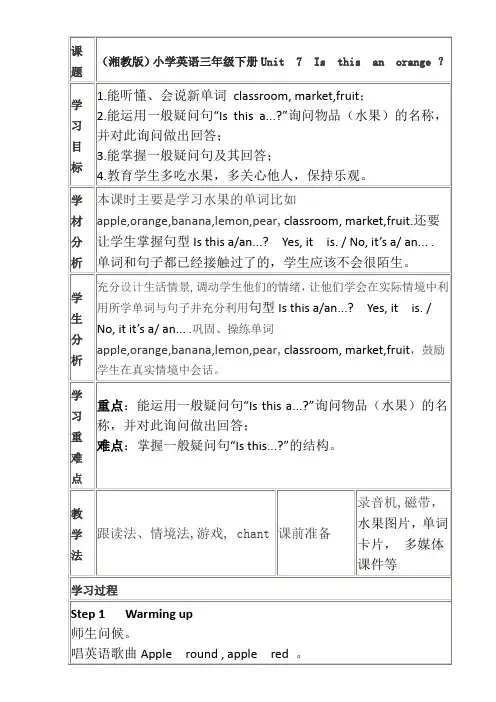
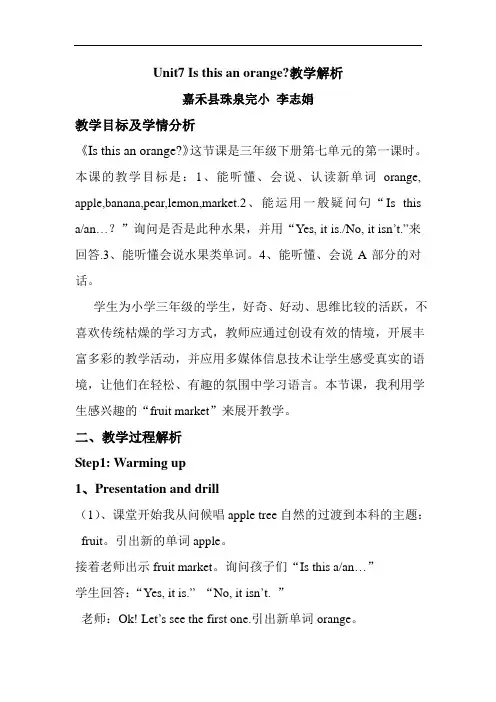
Unit7 Is this an orange?教学解析嘉禾县珠泉完小李志娟教学目标及学情分析《Is this an orange?》这节课是三年级下册第七单元的第一课时。
本课的教学目标是:1、能听懂、会说、认读新单词orange, apple,banana,pear,lemon,market.2、能运用一般疑问句“Is this a/an…?”询问是否是此种水果,并用“Yes, it is./No, it isn’t.”来回答.3、能听懂会说水果类单词。
4、能听懂、会说A部分的对话。
学生为小学三年级的学生,好奇、好动、思维比较的活跃,不喜欢传统枯燥的学习方式,教师应通过创设有效的情境,开展丰富多彩的教学活动,并应用多媒体信息技术让学生感受真实的语境,让他们在轻松、有趣的氛围中学习语言。
本节课,我利用学生感兴趣的“fruit market”来展开教学。
二、教学过程解析Step1: Warming up1、Presentation and drill(1)、课堂开始我从问候唱apple tree自然的过渡到本科的主题:fruit。
引出新的单词apple。
接着老师出示fruit market。
询问孩子们“Is this a/an…”学生回答:“Yes, it is.”“No, it isn’t. ”老师:Ok! Let’s see the first one.引出新单词orange。
用同样的方法引出新的单词(banana,pear,lemon)课件出示这些水果的图片。
(2)Magic eyes(课件快速闪现本课所学的水果的图片,学生快速的说出英文)2、Practice1、Listen to the dialogues and answer the question.Q:Which words or sentences did you hear?2、Listen again and answer the questions.3、Listen and repeat.4、Read the dialogues in roles.这部分主要是关注文本的学习。
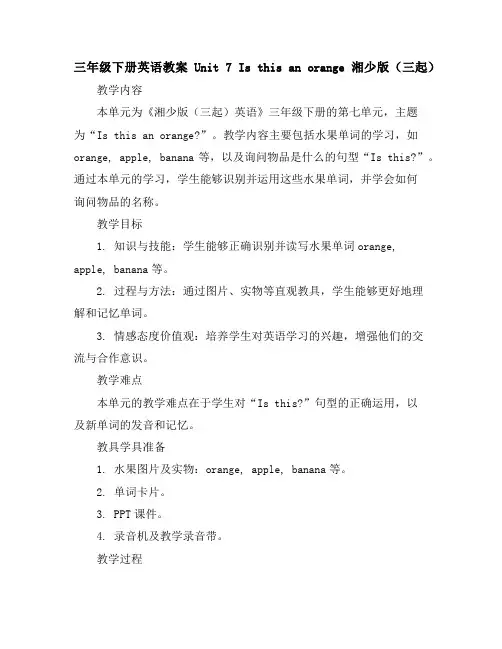
三年级下册英语教案Unit 7 Is this an orange 湘少版(三起)教学内容本单元为《湘少版(三起)英语》三年级下册的第七单元,主题为“Is this an orange?”。
教学内容主要包括水果单词的学习,如orange, apple, banana等,以及询问物品是什么的句型“Is this?”。
通过本单元的学习,学生能够识别并运用这些水果单词,并学会如何询问物品的名称。
教学目标1. 知识与技能:学生能够正确识别并读写水果单词orange, apple, banana等。
2. 过程与方法:通过图片、实物等直观教具,学生能够更好地理解和记忆单词。
3. 情感态度价值观:培养学生对英语学习的兴趣,增强他们的交流与合作意识。
教学难点本单元的教学难点在于学生对“Is this?”句型的正确运用,以及新单词的发音和记忆。
教具学具准备1. 水果图片及实物:orange, apple, banana等。
2. 单词卡片。
3. PPT课件。
4. 录音机及教学录音带。
教学过程1. 课堂导入:通过展示水果图片,引导学生猜测并复习之前学过的水果单词。
2. 新知呈现:利用PPT展示新单词,教师领读并解释单词意义。
3. 句型练习:通过小组活动,学生用“Is this?”句型询问并识别水果。
4. 听力训练:播放录音,学生跟读并模仿正确的语音语调。
5. 角色扮演:学生分角色扮演,运用所学句型和单词进行对话练习。
板书设计新单词:orange, apple, banana句型:Is this?作业设计1.抄写新学的水果单词。
2.用“Is this?”句型造句,至少三句。
3.家长辅助练习:与家长一起用英语识别家中的水果。
课后反思本节课通过丰富的教学活动和直观的教具,帮助学生有效地掌握了新单词和句型。
然而,部分学生在句型运用上仍存在困难,需要在今后的教学中加强练习和指导。
应更多地鼓励学生开口说英语,提高他们的口语表达能力。

